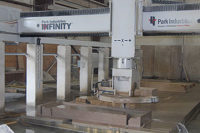In this issue of Stone World, we see the full range of the stoneworking spectrum - from old-fashioned hand tooling to computerized automation. Our cover story features McClurg Hall at the University of the South in Sewanee, TN, which is clad in Tennessee sandstone (page 46). The stone, which was used in the form of rough-faced blocks, is not only classic in its detailing, but also in the way it was quarried and fabricated.
Much of the stone was actually quarried on the University campus, and extracting the stone relies much more on ingenuity than on technology. The sandstone is taken from ledges, which are scattered throughout the campus. "We actually had three quarry sites where we pulled the stone for McClurg Hall, but there are hundreds around," explained stonemason Houston King. The stone was extracted from the ledges using air drills, followed by the traditional feather-and-wedge method of quarrying. Once the blocks were pulled, they were processed on a wire saw that had been sitting on the campus for decades. "The old wire saw fired right back up," King said, adding that it was updated with diamond wire to improve its performance. "We also set up a saw at the quarry, where we sawed blocks. We designed that saw with old elevator rails that were taken from the library on campus."
The artistry of the stoneworking in Sewanee was not lost on the architects at Hardy Holzman Pfeiffer Associates (HHPA), which designed the project. "Typically, for our projects we worked with outfits that specialize in architecturally cut stone, and there is a lot of machinery used," said Robert Almodovar, AIA, HHPA Senior Associate. "On this project, you could go out to the fabricating shop and see these guys, chisel in hand, facing the stone and shaping the stone. I was amazed by the way they were handling the material."
On the opposite end of the scale, this issue of Stone World profiles a fabricator in The Netherlands as part of our "Report from Europe." The company, Arte di Granito, has equipped its factory so that the entire production process - from order intake up to final delivery - is automated (page 100). In addition to computerized sawing, edging and stoneworking machinery, the plant features a high-tech transportation and warehousing system that is fully controlled by automation and is designed to safely route slabs and cut-to-size stones to their processing or warehouse storage locations.
In the automated warehouse, slabs are identified by their individual barcodes, and they are automatically delivered to the fabrication areas as needed. The nesting process considers the need for individual countertop parts - based on orders in the processing system - and the available effective surface of the raw slabs in the warehouse, taking into account the exact geometry and the defects of each slab. The total plant capacity is 400 countertop orders on a weekly basis with only 15 to 20 operators in two shifts. But even with all of this automation, the final step - manual quality control - relies on experience and knowledge of the worker.
Judging by the successful results at The University of the South and in The Netherlands, it appears that the methods and finishes for fabricating natural stone will remain as diverse as the material itself. And as stone fabricators continues to embrace new technology while also honing the skills of its current and new members, the industry as a whole will continue to flourish.
